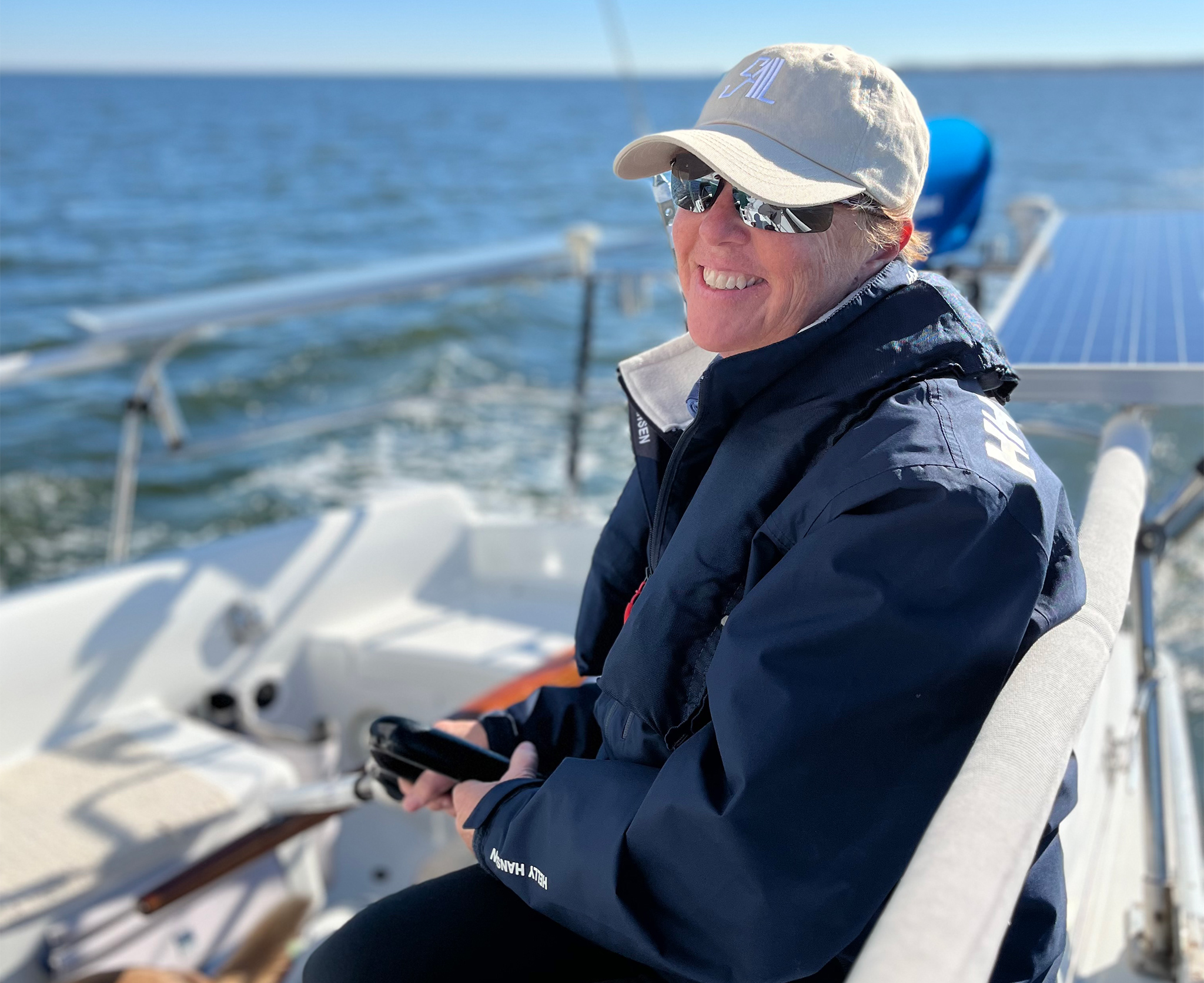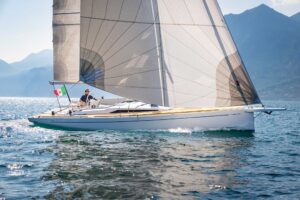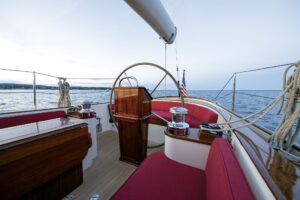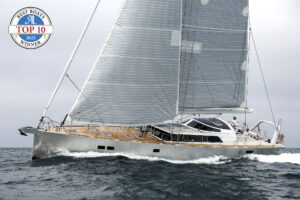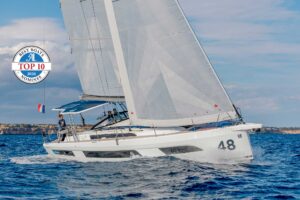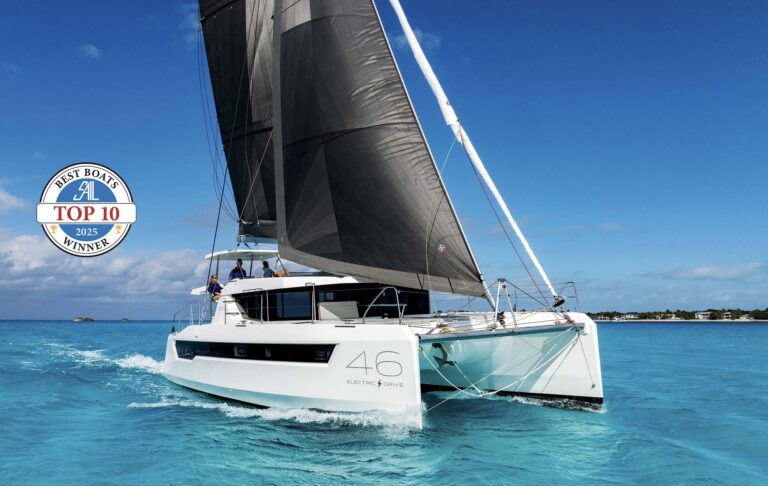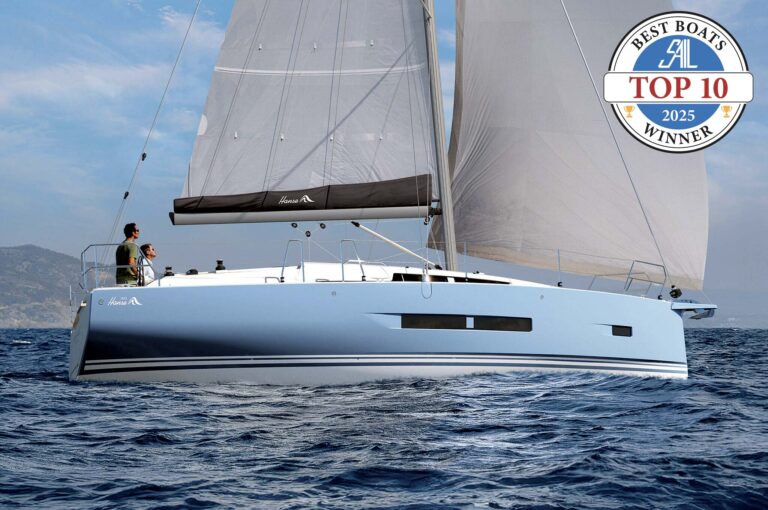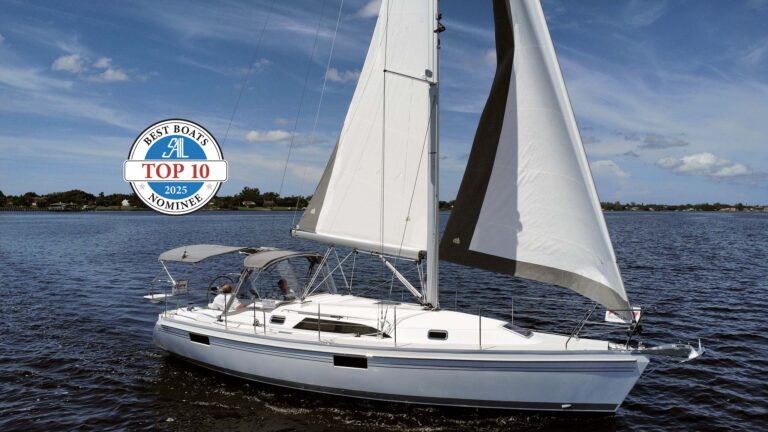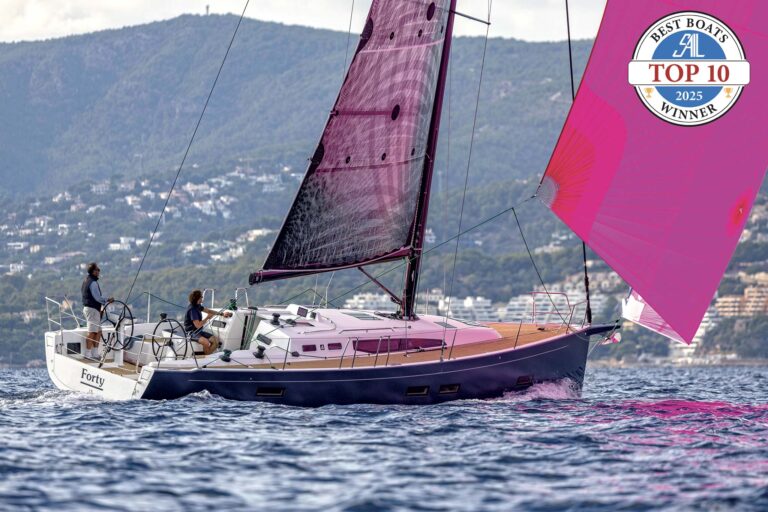For more multihull reviews and stories, subscribe for free to Multihull Power & Sail
Good things come to those who wait, and sailing the HH44-SC confirmed the adage. Even under delivery sails—and only a main and genoa, at that—we fairly flew across the Chesapeake Bay on a breezy fall day after the U.S. Sailboat Show in Annapolis, where hull No. 2 had missed a debut on the docks by just days.

When this intriguing new design did arrive, we were eager to spend time with it—and so, evidently, were lots of other people. Tied up across the harbor from where the boat show was dismantling, this boat was a traffic-stopper, looking screaming fast sitting still and drawing the attention of anyone who passed by. While the execs at HH stress that the 44 was designed as a luxurious, bluewater cruising cat, there’s no mistaking the performance lineage here. HH built its reputation and earlier boats on the designs of speedsters Morelli & Melvin, and while this new 44 was designed in-house—by Hudson Yacht Group naval architect James Hakes, son of HH co-founder Paul Hakes—that DNA is still evident in the boat’s rakish profile, 10-foot-long, pre-preg carbon daggerboards, and 64-foot, fractional carbon spar, which topped out at 72 feet with the standard, grounded lightning rod. And, Morelli & Melvin still had input here, designing all underwater appendages, including boards and rudders.
Likewise, certain elements are not what you’d associate necessarily with a “cruise-y” boat, such as load cells built into the cap shrouds that help determine when best to reef, an integrated hydraulic mast base jack to tune the rig (no turnbuckles), carbon throughout the build, and a fully 48-volt boat powered with electrical and systems engineering that it’s safe to say may demand a fairly steep learning curve.
However, as HH President Seth Hynes pointed out, what drove this boat’s design from conception was demand from sailors who are eager for the leading tech edge—and that is the push toward more dependable electrification of propulsion and living systems aboard.
“Our owners drive Teslas, they’ve been looking at the industry a long time and asking, ‘Why aren’t there more electric boats out there?’ ” Hynes said. “We’re trying to build the best quality cruising cat. To do that, we’re excited about the electrification of boats. It seems like we’re a decade behind cars, and we’re on the cusp of it really coming into the marine industry. There’s been a lot of attempts to do it, but in looking at it, we feel they tried to modify existing boats to make them electric, rather than building one from the ground up to be electric.”
As a result, of all the boats the SAIL Top 10 Best Boats review team saw for 2024, none put sustainable sailing as far in the forefront as the HH44. There are two models, OC—Ocean Cruising—and SC—Sports Cruising, and they are significantly different. HH says the SC is quickly proving the most popular; that’s the version we saw in Annapolis and on which this review focuses.

The sustainability emphasis centers around the boat’s EcoDrive, a hybrid diesel electric system whose backbone is a 43.2 KwH 48V lithium ion battery bank fed in part by a whopping 4,232-watt solar array on the cabintop. Two 30-hp Beta diesels have a traditional gearbox and shaft, but rather than an alternator, an electric motor generator is connected to the prop shaft with a belt, controlled with a mechanical clutch. The boat’s two 10-kw electric motors (each about 15hp) can be used independently as silent, fume-free electric propulsion, providing about two hours of full-throttle run time at 8.5 knots (3,000 rpm at 120 amps), or a half-throttle cruise speed of 6 knots for about five hours. They also can be engaged essentially as alternators while motoring under diesel power, generating 5 kw each at 48 V DC power directly into the batteries. And, the system has hydropower capability built in; while sailing, the propeller can free spin, rotating the shaft and allowing the electric motor to act as a generator to feed the batteries.
Hynes said some customers want fully electric boats, but “we felt that it doesn’t qualify for being a safe bluewater boat. You could be on a lee shore, in a storm, there isn’t sun, you don’t have a way to charge. We really felt the redundancy of having a traditional diesel with the electric drive was the way to go.”
With the cabintop devoted to solar, the helms are aft in the cockpit, right behind an L-shaped settee to port with a table and in-line settee opposite. This immediately begs the forward visibility question, which HH addresses with Jefa helms that swing through an arc into three positions. With the helm outboard, I had no problem seeing the telltales and the bow, and I could either lean on the hull side or perch on a clever pocket seat here.

With a step on a lever, I could swing the helm inboard to be more protected–although here I relied on instruments since I couldn’t see the telltales. I could see the bow through the salon’s massive, opening windows on carbon frames, although the starboard helm had an obscuring glare from the salon door that slides across (they’re working on that problem, Hynes said).
Both helms had 12-inch B&G displays (as well as one at the nav station) and equivalent controls in terms of throttle and panels—no dashing from one side to another to drive the boat under power. Mainsail controls were led aft to the port helm (the Antal mainsheet traveler and car system was on the cabintop) and headsail controls to the starboard helm, with daggerboard controls on both sides. Two Harken electric winches just forward of each wheel managed all of this with foot controls.
Halyard and line tails vanished into storage buckets under the aft end of the settees, easily accessible when you lift that section of the seat. There’s a lot going on at these helms, but they’re well laid out, moving between and around them was easy, and your family and friends are right there in the cockpit or salon as you’re sailing the boat.

From each helm, two steps up led to the wide side decks and forward, with lifelines on 35-inch-high stanchions. Behind each helm was an especially smart safety feature for sailing offshore—vertical transoms with carbon, drop-down swim platforms, easily lowered via line and winch, that effectively added 4 more feet to the boat while at anchor and fully enclosed the cockpit while sailing. Thoughtful boarding doors were incorporated into the hull sides here for stepping into the cockpit from a dock or dinghy.
With the coachroof relatively low, boom height is also lower, which translates into a lower center of effort and the ability to put more power into the sails. It also means that with two easy steps up, I was on the cabintop and right next to the hayrack boom at waist-height (at 5 feet 4 inches tall), providing excellent access to the 779-square-foot, square-top main with Anomaly headboard.
On deck, the curved track for an optional self-tacking jib was just forward of the mast step; Hynes says most owners opt for an overlapping Solent genoa—tracks on the cabintop—with an inner staysail and a fractional reacher and/or A-sail on the sprit.
At the bow, the longeron, cross beam, and striker are a single carbon structure. In a clever piece of engineering, the anchor rode passes through the longeron with an automatic washdown that comes on when the windlass is activated. The 48-volt Lewmar V3 electric windlass itself was easily accessible under the port forward hatch. Both hulls had carbon fiber hatches all the way forward providing access to deep sail lockers; this is also where the first collision bulkhead is located—the boat has four watertight bulkheads in each hull with a bilge pump serving each compartment.

Construction is a carbon-reinforced, foam composite sandwich with infused epoxy resin. The boat’s entire skeleton—bulkheads, beams, hulls, deck—is carbon fiber, with external e-glass, also epoxy infused. Extra carbon is added for strength in high-load areas such as chainplates, and all bulkheads are bonded in carbon taping and epoxy. This all makes for a strong, light, slippery boat.
Cockpit, side decks and foredeck were SeaDek, which felt fantastic underfoot—grippy, secure, and a little forgiving.
This boat’s layout puts the owner’s cabin in the port hull, with a head and shower forward and queen berth aft. The whole berth lifts on gas struts to expose the hybrid propulsion system, providing terrific access for maintenance; the same is true under the starboard aft berth. The bunk tops are insulated for noise and heat; still, I’d be curious if under power you’d feel them underneath you.
Forward in the starboard hull is a smaller berth. A shared head is midships, as well as access to the boat’s rather astonishing battery and technical space that resembles the business end of a small powerplant. The forward starboard cabin can also be configured for bunkbeds or a workshop.
In the salon, a C-shaped galley is aft and to port with a four-burner electric Bosch stove, microwave, and convection oven. The fridge opposite has two drawers, both programmable to be fridge or freezer. There’s an option for a fridge in a third drawer, a plug for a standalone, Engel-type of freezer, and Hynes said they can build an additional custom freezer into the bilge.

Forward of the galley, an enormous, L-shaped nav station with a 16-inch B&G display—option to go to 24 inches—provides ample space to be a home office with views to die for. An L-shaped dinette is opposite. The overall style is quite lean and minimalist, with terrific natural light and ventilation everywhere—you’re only going to need AC in the hottest of places and no breeze.
Our test sail day provided plenty of breeze, and we banged around a bit heading out of a choppy Severn River under the full main and jib in about 17 knots of true wind, making 9 knots of boatspeed at an apparent wind angle of 40 degrees. Further out in the Bay, with the leeward board down at 7 feet and the wind still between 17 and 18 knots, we climbed to 10.2 knots at an AWA of 47, and when we opened up the angle a bit more, we popped up to 11 knots. Despite the chop, we were dry and comfortable aft, and the helm was well balanced.
Hynes said that in fact, light air performance was the emphasis in this boat’s design. “People think performance is all about being a Ferrari,” he said. More useful is when a boat can sail at windspeed when it’s only blowing 5 or 6 knots. “To be able to go 8 knots when everyone else is motoring is the best.”
We wouldn’t get to test that on this day, though. Pushing upwind to an AWA of 30 in 16 knots of true wind, the HH held to 9.5 knots. And bearing off, wishing for some downwind sails but limited to the delivery jib, we made about 8 knots at 150 AWA heading back into the river. We fired up the diesel for the short run back to the dock; 2,500 rpm gave us 8 knots, 1,800 rpm, 6 knots.
There is, as they say, a lot to unpack in this new design, and you could probably devote an entire review just to its electrical and propulsion systems. For the uninitiated, this new 48-volt world can be a bit intimidating, and I’d certainly want to go to school on the systems and redundancies before I took off for points unknown. But you can’t come away from this boat without feeling like you’ve just sailed on something that’s truly pushing forward, and in that respect, HH has succeeded in its goal.

LOA/LWL 50’2”/43’10”
Beam 23’5”
Draft 4’3” (up) 9’9” (down)
Air draft 72’2”
Displacement 22,487 (light)
Sail Area 1,254 sq ft (main and Solent)
Power Beta 30hp diesel (2) and 10kW electric (2)
Designer Hudson Yacht & Marine Ltd.
Builder HH Catamarans, hhcatamarans.com
Price as sailed $1.5 million (OC version starts at $995,000)
For more multihull reviews and stories, subscribe for free to Multihull Power & Sail

May 2024

